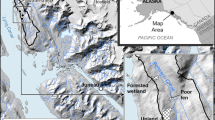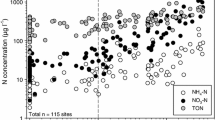Abstract
Many ecologists and biogeochemists explore the interaction of the nitrogen (N) and phosphorus (P) cycles by addressing N:P ratios. While N:P ratios are recognized as broadly important to the composition and functioning of lotic ecosystems, the fundamental controls on stream water N:P ratio variation remains poorly understood. Low N:P ratio (less than 16) streams appear more likely in arid climates than in mesic climates, suggesting possible hydrologic or landscape controls. We explored the importance of watershed hydrology to the variation of total N to total P (TN:TP) ratios in stream water, and whether such variation is characteristically different across watershed classes based on mean annual precipitation and median observed TN:TP ratio. Nonparametric scatter plot analysis was applied to normalized TN:TP ratios and associated discharge (Q) measurements from 57 minimally-impacted watersheds from the contiguous United States. At the seasonal scale, TN:TP ratios showed a negative relationship with Q in semiarid climates and a positive relationship with Q in humid climates. Over storm event scales, TN:TP ratios decline with increasing Q across all watershed classes. The results broadly indicate hydrology is an important driver of TN:TP ratio variation over multiple time scales. We hypothesize that the broad differences across watershed classes are driven by variation in the nature of connectivity (frequency and magnitude of connections) of the landscape to streams. A strong physical control of N:P ratios in stream water is in stark contrast to the biological control of N:P ratios in the oceans, suggesting that application of stoichiometric theory—developed using marine systems—to lotic systems requires a broader consideration of controlling factors.












Similar content being viewed by others
References
Arbuckle KE, Downing JA (2001) The influence of watershed land use on lake N:P in a predominantly agricultural landscape. Limnol Oceanogr 46:970–975
Babiker IS, Mohamed MAA, Komaki K, Ohta K, and Kato K (2004) Temporal variations in the dissolved nutrient stocks in the surface water of the western North Atlantic Ocean. J Oceanogr 60:553–562
Billen G et al (1991) N, P, and Si retention along the aquatic continuum from land to ocean. In: Mantoura RFC, Martin J-M, Wollast R (eds) Ocean margin and processes in global change. Wiley, New York
Borchardt MA (1996) Nutrients. In: Stevenson RJ, Bothwell ML, Lowe RL (eds) Algal ecology. Academic Press, San Diego
Bowes MJ, Leach DV, House WA (2005) Seasonal nutrient dynamics in a chalk stream: the River Frome, Dorset, UK. Sci Total Environ 336:225–241
Brookshire ENJ, Valett HM, Gerber S (2009) Maintenance of terrestrial nutrient loss signatures during in-stream transport. Ecology 90:293–299
Correll DL, Jordan TE, Weller DE (1999) Transport of nitrogen and phosphorus from Rhode River watersheds during storm events. Water Resour Res 35:2513–2521
Creed IF, Band LE, Foster NW, Morrison IK, Nicolson JA, Semkin RS, Jeffries DS (1996) Regulation of nitrate-N release from temperate forests: a test of the N flushing hypothesis. Water Resour Res 32(11):3337–3354
Detenbeck NE, Elonen CM, Taylor DL, Anderson LE, Jicha TM, Batterman SL (2004) Region, landscape, and scale effects in Lake Superior tributary water quality. J Am Water Resour As 40:705–720
Dodds WK (2003) Misuse of inorganic N and soluble reactive P concentrations to indicate nutrient status of surface waters. J North Am Benthol Soc 22:171–181
Downing JA and McCauley E (1992) The nitrogen–phosphorus relationship in lakes. Limnol Oceanogr 37:936–945
Evans C, Davies TD (1998) Causes of concentration/dicharge hysteresis and its potential as a tool for analysis of episode hydrochemistry. Water Resour Res 34:129–137
Famiglietti JS, Ryu D, Berg AA, Rodell M, Jackson TJ (2008) Field observations of soil moisture variability across scales. Water Resour Res 44:W01423. doi:10.1029/2006WR005804
Fitzhugh RD, Driscoll CT, Groffman PM, Tierney GL, Fahey TJ, Hardy JP (2001) Effects of soil freezing disturbance on soil solution nitrogen, phosphorus, and carbon chemistry in a northern hardwood ecosystem. Biogeochemistry 56:215–238
Francoeur SN, Biggs BJF, Smith RA, Lowe RL (1999) Nutrient limitation of algal biomass accrual in streams: seasonal patterns and a comparison of methods. J North Am Benthol Soc 18:242–260
Frost PC, Kinsman LE, Johnston CA, Larson JH (2009) Watershed discharge modulates relationships between landscape components and nutrient ratios in stream seston. Ecology 90:1631–1640
Giani M, Savelli F, Boldrin A (2003) Temporal variability of particulate organic carbon, nitrogen and phosphorus in the Northern Adriatic Sea. Hydrobiologia 494:319–325
Green MB, Finlay JC (2008) Detecting characteristic hydrological and biogeochemical signals through nonparametric scatter plot analysis of normalized data. Water Resour Res 44:W08455. doi:10.1029/2007WR006509
Green MB, Fritsen CH (2006) Spatial variation of nutrient balance in the Truckee River, California-Nevada. J Am Water Resour Assoc 42:659–674
Green MB, Wang D (2008) Watershed flow paths and stream water nitrogen-to-phosphorus ratios under simulated precipitation regimes. Water Resour Res 4:W12414. doi:10.1029/2007WR006139
Green MB, Nieber JL, Johnson G, Magner J, Schaefer B (2007) Flow path influence on an N:P ratio in two headwater streams: a paired watershed study. J Geophys Res 112:G03015. doi:10.1029/2007JG000403
Green MB, Wollheim WM, Basu N, Gettel G, Rao PS, Morse N, Stewart R (2009) Effective denitrification scales predictably with water residence time across diverse systems. Available from Nature Precedings: http://hdl.handle.net/10101/npre.2009.3520.1
Grimm NB, Fisher SG, Mickley WL (1981) Nitrogen and phosphorus dynamics in hot desert streams of Southwestern USA. Hydrobiologia 83:303–312
Guildford SJ, Hecky RE (2000) Total nitrogen, total phosphorus, and nutrient limitation in lakes and oceans: is there a common relationship?. Limnol Oceanogr 45:1213–1223
Hecky RE, Campbell P, Hendzel LL (1993) The stoichiometry of carbon, nitrogen, and phosphorus in particulate matter of lakes and oceans. Limnol Oceanogr 38:709–724
Hill AR, Labadia CF, Sanmugadas K (1998) Hyporheic zone hydrology and nitrogen dynamics in relation to the streamed topography of a N-rich stream. Biogeochemistry 42:285–310
Hill AR, Kemp WA, Buttle JM, Goodyear D (1999) Nitrogen chemistry of subsurface storm runoff on forested Canadian Shield hillslopes. Water Resour Res 35:811–821
Horne AJ, Goldman CR (1994) Limnology. McGraw Hill, New York
House WA, Warwick MS (1998) Hysteresis of the solute concentration. Water Res 32:2279–2290
Jarvie HP, Withers PJA, Hodgkinson R, Bates A, Neal M, Wickham HD, Harman SA, Armstrong L (2008) Influence of rural land use on streamwater nutrients and their ecological significance. J Hydrol 350:166–186
Jencso KG, McGlynn BL, Gooseff MN, Wondzell SM, Bencala KE, Marshall LA (2009) Hydrologic connectivity between landscapes and streams: transferring reach- and plot-scale understanding to the catchment scale. Water Resour Res 45:W04428. doi:10.1029/2008WR007225
Kaushal SS, Groffman PM, Band LE, Shields CA, Morgan RP, Palmer MA, Belt KT, Swan CM, Findlay SEG, Fisher GT (2008) Interaction between urbanization and climate variability amplifies watershed nitrate export in Maryland. Environ Sci Technol 42:5872–5878. doi:10.1021/es800264f
McGroddy ME, Baisden WT, Hedin LO (2008) Stoichiometry of hydrological C, N, and P losses across climate and geology: an environmental matrix approach across New Zealand primary forests. Global Biogeochem Cycles 22:GB1026. doi:10.1029/2007GB003005
Meybeck M (1982) Carbon, nitrogen, and phosphorus transport by world rivers. Am J Sci 282:401–450
Meyer JL, Likens GE, Sloane J (1981) Phosphorus, nitrogen, and organic carbon flux in a headwater stream. Arch Hydrobiol 91:28–44
Mulholland PJ, Hill WR (1997) Seasonal patterns in streamwater nutrient and dissolved organic carbon concentrations: separating catchment flow path and in-stream effects. Water Resour Res 33:1297–1306
Newbold JD, ONeill RV, Elwood JW, VanWinkle W (1982) Nutrient spiralling in streams. Implications for nutrient limitation and invertebrate activity. Am Nat 120(5):628–652
Newman BD, Vivoni ER, Groffman AR (2006) Surface water-groundwater interactions in semiarid drainages of the American southwest. Hydrol Process 20:3371–3394. doi:10.1002/hyp.6336
Pacini N, Gachter R (1999) Speciation of riverine particulate phosphorus during rain events. Biogeochemistry 47:87–109
Ptacnik R, Jenerette GD, Verschoor AM, Huberty AF, Solimini AG, Brookes JD (2005) Applications of ecological stoichiometry for sustainable acquisition of ecosystem services. Oikos 109:52–62
Redfield AC (1958) The biological control of chemical factors in the environment. Am Sci 46:205–221
Sabo JL, Post DM (2008) Quantifying periodic, stochastic and catastrophic variation in the environment using time series of environmental conditions. Ecol Monogr 78:19–40
Saunders TJ, McClain ME, Llerena CA (2006) The biogeochemistry of dissolved nitrogen, phosphorus, and organic carbon along terrestrial-aquatic flowpaths of a montane headwater catchment in the Peruvian Amazon. Hydrol Process 20:2549–2562. doi:10.1002/hyp.6215
Smith RA, Alexander RB, Schwarz GE (2003) Natural background concentrations of nutrients in streams and rivers of the conterminous United States. Environ Sci Technol 37:3039–3047
Stelzer RS, Lamberti GA (2001) Effects of N:P ratio and total nutrient concentration on stream periphyton community structure, biomass, and elemental composition. Limnol Oceanogr 46:356–367
Stieglitz M, Shaman J, McNamara J, Engel V, Shanley J, Kling GW (2003) An approach to understanding hydrologic connectivity on the hillslope and the implications for nutrient transport. Global Biogeochem Cycles 17:1105. doi:10.1029/2003GB002041
Turner RE, Rabalais NN, Justic D, Dortch Q (2003) Global patterns of dissolved N, P and Si in large rivers. Biogeochemistry 64:297–317. doi:10.1023/A:1024960007569
UNEP (2002) World’s water cycle: schematic and residence time. In: UNEP/GRID-Arendal Maps and Graphics Library, Retrieved 16:19, October 2, 2008 from http://maps.grida.no/go/graphic/world_s_water_cycle_schematic_and_residence_time
Walvoord MA, Phillips FM, Stonestrom DA, Evans RD, Hartsough PC, Newman BD, Striegl RG (2003) A reservoir of nitrate beneath desert soils. Science 302:1021–1024. doi:10.1126/science.1086435
Watson VJ, Loucks OL, Wojner W (1981) The impact of urbanization on seasonal hydrologic and nutrient budgets of a small North American watershed. Hydrobiologia 77:87–96
Western AW, Blöschl G, Grayson RB (2001) Towards capturing hydrologically significant connectivity in spatial patterns. Water Resour Res 37:83–97
Wold AP, Hershey AE (1999) Spatial and temporal variability of nutrient limitation in 6 North Shore tributaries to Lake Superior. J North Am Benthol Soc 18:2–14
Acknowledgments
We thank two anonymous reviewers whose insights improved the communication of this work. This work was supported by the STC program of the National Science Foundation via the National Center for Earth-Surface Dynamics under Agreement EAR-0120914. Also, M.G. was supported via a USDA National Needs Fellowship.
Author information
Authors and Affiliations
Corresponding author
Rights and permissions
About this article
Cite this article
Green, M.B., Finlay, J.C. Patterns of hydrologic control over stream water total nitrogen to total phosphorus ratios. Biogeochemistry 99, 15–30 (2010). https://doi.org/10.1007/s10533-009-9394-9
Received:
Accepted:
Published:
Issue Date:
DOI: https://doi.org/10.1007/s10533-009-9394-9




